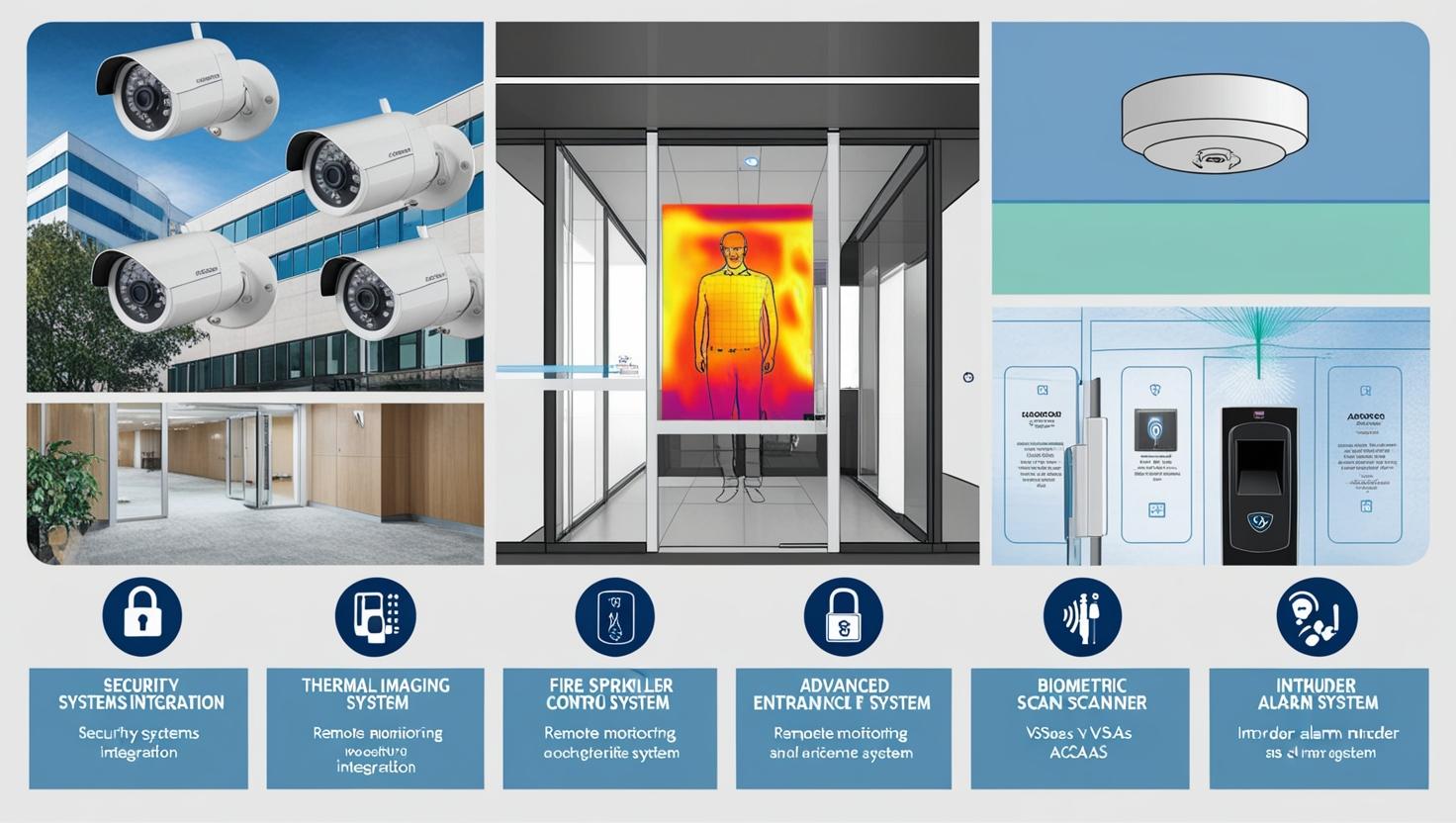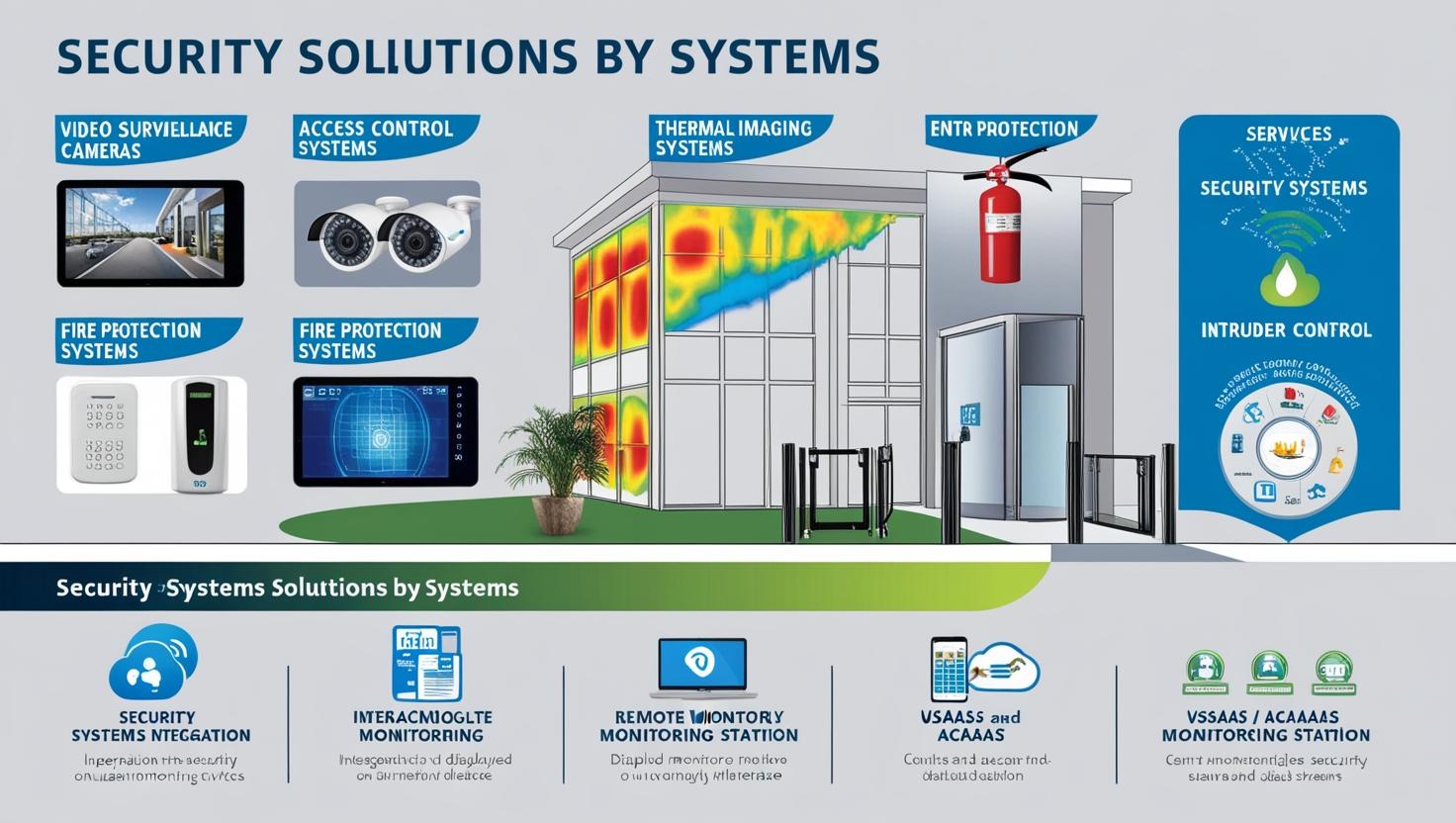The global security solutions market is undergoing a significant transformation, fueled by rapid advances in smart technologies, cloud computing, and integrated systems architecture. As organizations across sectors seek more intelligent, scalable, and proactive security strategies, traditional standalone systems are giving way to next-generation solutions that blend physical and digital security.
From smart surveillance cameras and biometric access control to fire safety and cloud-based services like VSaaS (Video Surveillance as a Service) and ACaaS (Access Control as a Service), the security industry is entering a new phase of dynamic growth and technological convergence.

Smart Systems Redefining Physical Security Infrastructure
The modern security environment demands more than reactive measures—it requires predictive, automated systems capable of real-time detection and rapid response. Video surveillance, one of the largest segments in the market, has evolved dramatically with the infusion of AI, edge analytics, and high-definition IP cameras. Intelligent video systems now detect anomalies, recognize faces, and generate instant alerts, making them essential not only for security but also for operational efficiency.
Access control has also become increasingly sophisticated, moving from traditional keycard-based systems to touchless biometric authentication, mobile credentialing, and cloud-managed access. ACaaS enables businesses to control and audit access remotely, scaling security across multiple sites without heavy infrastructure investments.
Thermal imaging systems are gaining popularity for perimeter surveillance, temperature screening, and monitoring in low-visibility conditions. These are particularly valuable in industrial environments, critical infrastructure, and border control.
Fire protection systems are becoming smarter and more interconnected, with sensors that communicate across networks to trigger alarms, suppression systems, and emergency response protocols in real time. Modern fire safety is no longer siloed but integrated into broader building automation and life safety ecosystems.
Entrance control and intruder alarm systems are also evolving with smart gates, automated barriers, and AI-enhanced motion detection. These systems form the first line of defense and are increasingly linked with centralized security operations centers for improved visibility and response.
Services Enabling Scalable, Cloud-Based Security Management
Beyond hardware, the growth of the security market is heavily driven by services that enable flexibility, scalability, and lower capital costs. Security systems integration services are in high demand as organizations seek to unify legacy systems with new, intelligent platforms. Integration ensures that various subsystems—video, access, fire, alarms—work seamlessly together, improving response times and situational awareness.
Remote monitoring services allow businesses to outsource 24/7 surveillance operations to professional monitoring centers, improving efficiency and response while reducing on-site staffing needs. Real-time alerts, mobile notifications, and live video access are now standard expectations for many enterprises.
Cloud-based services like VSaaS and ACaaS are revolutionizing the way organizations manage security. VSaaS offers offsite storage, AI analytics, and remote camera management, making it ideal for multi-location businesses, small and medium enterprises, and smart city projects. ACaaS delivers centralized control of entry systems via the cloud, supporting hybrid work environments, co-working spaces, and facilities with fluctuating access needs.
Market Growth Across Verticals and Regions
The global security solutions Industry size is expected to be valued at USD 354.7 billion in 2024 and is projected to reach USD 502.1 billion by 2029; it is expected to grow at a CAGR of 7.2% from 2024 to 2029. The proliferation of smart cities, critical infrastructure projects, and the escalating emphasis on data protection and privacy further propel the demand for innovative security solutions, fostering continuous market expansion.
Download PDF Brochure @ https://www.marketsandmarkets.com/pdfdownloadNew.asp?id=701

Adoption of next-gen security solutions is widespread across verticals, including commercial real estate, healthcare, education, transportation, manufacturing, and government. Retailers are deploying cloud-based surveillance and access control to combat theft and monitor store traffic. Hospitals integrate smart fire protection and access systems to ensure safety while maintaining HIPAA compliance. Airports and transport hubs are using thermal and video analytics for crowd control and perimeter defense.
Regionally, North America and Europe continue to lead in adoption due to strong regulatory frameworks and mature infrastructure. However, the Asia-Pacific region is emerging as a high-growth market, with smart city initiatives, rising urbanization, and increasing public safety concerns accelerating deployments.
Opportunities in the Next-Gen Security Solutions Market :
Expansion of Smart Cities and Critical Infrastructure
The global push toward smart cities is creating significant demand for advanced, integrated security solutions. Municipalities are investing in systems like AI-powered video surveillance, access control, and fire protection that can be centrally monitored and managed through cloud platforms. This opens up opportunities for vendors to deploy end-to-end security ecosystems that integrate with city-wide command centers, traffic systems, and emergency response networks.
Rising Adoption of Cloud-Based Security Services
The shift toward cloud computing is unlocking new revenue models, especially in the form of VSaaS (Video Surveillance as a Service) and ACaaS (Access Control as a Service). These platforms reduce upfront costs and provide scalable, pay-as-you-go solutions that appeal to small and mid-sized businesses, schools, hospitals, and retail chains. Providers offering hybrid cloud models that combine on-premise control with remote access are especially well-positioned to capture market share.
Increased Demand in Remote and Hybrid Work Environments
As hybrid and remote work models become permanent, organizations need more flexible and remotely manageable security systems. This includes mobile credentialing for access control, cloud-managed surveillance, and remote monitoring services. Companies that can offer secure, centralized management of distributed facilities will see strong demand from corporate, industrial, and educational clients
Integration with IoT and Building Automation
The convergence of physical security with building automation and IoT opens up cross-industry opportunities. Sensors used for HVAC, lighting, or occupancy monitoring can be integrated with intrusion detection, fire alarms, and surveillance to create intelligent buildings. Vendors that can deliver holistic, interoperable platforms—combining safety, energy efficiency, and automation—will stand out in competitive markets.
AI and Analytics as Differentiators
Advanced analytics, including facial recognition, behavioral analysis, and license plate recognition, add significant value to core security systems. These features enhance not just security but also business intelligence—helping retailers understand customer behavior or manufacturers detect workflow inefficiencies. Companies that integrate analytics into their security offerings can position themselves as partners in both safety and operational improvement.
Growing Demand in Emerging Markets
Developing countries are investing in modernizing infrastructure, with security seen as a high priority. This includes upgrades in public safety, transportation hubs, educational institutions, and healthcare. Vendors offering affordable, scalable, and cloud-ready solutions tailored for local conditions can establish a strong foothold in regions such as Southeast Asia, Africa, Latin America, and the Middle East.
Challenges and Considerations
While the benefits are clear, implementing next-gen security solutions comes with challenges. Data privacy remains a significant concern, particularly with facial recognition and cloud-based video storage. Regulatory compliance—especially with laws like GDPR and CCPA—requires strict data governance policies.
Integration complexity is another hurdle, especially for organizations with legacy systems that lack interoperability. Upfront investment costs for advanced analytics and intelligent hardware can also deter small businesses, though service-based models are helping lower entry barriers.
The Road Ahead: Unified, AI-Powered Security Ecosystems
As organizations continue their digital transformation journeys, security solutions are shifting from isolated tools to integrated platforms that serve broader business goals. The convergence of AI, IoT, and cloud is driving the development of unified security ecosystems—offering real-time insights, proactive threat detection, and centralized control.
Next-gen security isn’t just about protection—it’s about resilience, adaptability, and strategic value. From enabling business continuity to enhancing operational intelligence, security systems are becoming mission-critical components of the modern enterprise.
As the industry continues to innovate, companies that embrace smart, cloud-integrated security solutions will be better positioned to respond to evolving threats, comply with regulations, and create safer, smarter environments for people and assets alike.
Semiconductor and Electronics Market Research Reports
Frequently Asked Questions (FAQ): Next-Gen Security Solutions Market
1. What are next-gen security solutions?
Next-generation (next-gen) security solutions refer to advanced systems and services that combine traditional physical security tools with modern technologies such as artificial intelligence (AI), cloud computing, IoT, and edge analytics. These solutions enable real-time monitoring, intelligent automation, and remote management of security infrastructure across diverse sectors.
2. What types of systems are included in the next-gen security market?
The market includes a range of systems such as video surveillance, access control, thermal imaging, fire protection, entrance control, and intruder alarm systems. These are increasingly being integrated with AI and network-based technologies to enable smarter, faster, and more scalable security operations.
3. What services are driving growth in this market?
Key services include security systems integration, remote monitoring, VSaaS (Video Surveillance as a Service), and ACaaS (Access Control as a Service). These services allow organizations to outsource complex tasks, reduce hardware costs, and manage systems from anywhere via cloud-based platforms.
4. How does VSaaS work?
VSaaS enables users to access and manage video surveillance footage over the cloud. This eliminates the need for on-site storage and allows for real-time monitoring, AI-driven analytics, and centralized control from any internet-connected device. It is particularly beneficial for businesses with multiple locations or limited IT resources.
